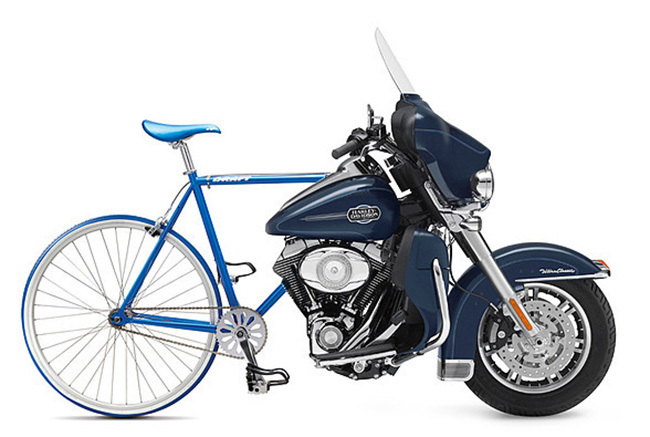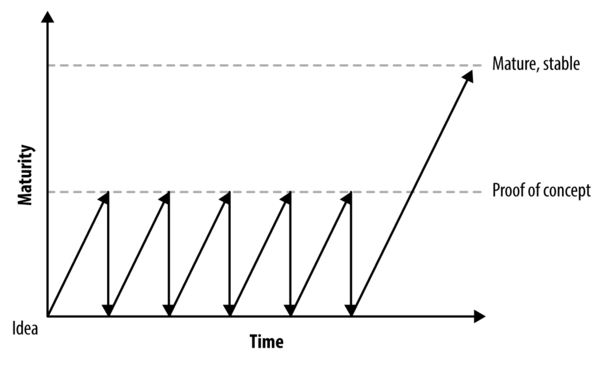A minimally viable product is not a product, but a process.

The same story repeats over and over again. First, a team of people illuminates the idea.
Then they create a minimally viable product as proof of the concept, spending a lot of time arguing about what features it is worth giving it, and what not. And in the end, if the minimum viable product proves successful, then they plan to create a fully developed, stable product.
')
But what is wrong here? Why for many startups does this turn into problems?
The problem is that these teams do not understand the essence of a minimally viable product. This is not just a product with reduced functionality or the ability to throw a product to the market earlier. In fact, a minimally viable product should not be a product at all. And this is not the product that you create only once, and then you think that this work is over.
“Do you know the old saying that planes from California to Hawaii leave the course 99% of the time, but they are constantly being adjusted? The same goes for successful startups - except that their new route can even lead to Alaska. ”- Evan Williams

As the founders believe, a minimum viable product will work.
A minimally viable product is a process that you repeat over and over: find the most risky assumption for you, test it at the lowest possible cost and use the results of the experiment to make corrections.
When you create a product, you make many assumptions. You assume that you know what users want, how the design should work, what marketing strategy to use, which architecture will be most effective, which monetization strategy will be the most rational in the long run, and which laws you should follow. No matter how good you are in your business, some of your assumptions will be wrong. The problem is that you do not know which ones (see note 1 at the end of the article).
Analyzing the reasons for the failure of more than 100 startups, CB Insights discovered that the main reason for the death of startups is that their product "did not meet the needs of the market." About half of these startups spent months, or even years, developing a product, before they realized that their most basic assumption was wrong: that this project was interesting to someone.
There is only one way to test this, only one way to test your assumptions is to offer your product to real users as quickly as possible. And when you do this, it often turns out that you need to return to the outline. In fact, you will have to return to them more than once, but again and again.

How a minimally viable product actually works.
This is not a unique product development. When you write a book or an article, you have to make a lot of sketches and spend a lot of time correcting the written text. And when you write code, you often need to reorganize or even rewrite the code (see note 2 at the end of the article). Every human creative activity is accompanied by many attempts and mistakes.

In the world of attempts and mistakes, the one who was able to quickly identify his mistakes wins. Some people call this philosophy "fail fast." At TripAdvisor, we call it “speed wins.” Kent Beck and other programmers call it Agile. Whatever you call it, the essence remains the same: as soon as possible to understand which of your assumptions are wrong thanks to the feedback of real users about your product.
Regardless of whether you are creating a product, writing code, or developing a marketing plan, you should always ask yourself two questions:
- Which of my assumptions is most at risk?
- What is the smallest experiment I can do to test this assumption?
Minimally viable product as a process in action
Let's look at one example.
You have decided to develop a product that allows restaurant owners to create a mobile application for their restaurants with just a few mouse clicks. You have a simple drag-and-drop interface, a set of predefined templates, an event calendar, newsletter, registration, photo gallery, online chat, integration with review sites, social networks and Google Maps. And the most important thing is that you offer the possibility to make reservations, place orders for meals at home and use coupons, which will be the source of your monetization. It must be great!
You find some friends who become your co-founders, if you are a typical start-up team, you collect money, close in four walls for 12 months and try to implement all these functions. If you think more sensibly, then you give up functions that are not important for the first product launch, then you will be able to launch your “minimum viable product” in 8 months, not 12.
And in both cases, most likely, you will fail.
Why? Well, think how many of your assumptions may be wrong, which will later turn into a catastrophe:
- You spent months figuring out how to create specialized mobile apps for your customers, then discover that restaurant owners really want a mobile-optimized website that can be quickly found on Google.
- Or after you have used all the latest technologies to create an online chat, you discover that restaurant owners can hardly cope with the mail and are not going to sit at the computer all day.
- Or the worst - you may find that restaurant owners do not want to deal with modern IT technologies and create mobile applications, and first of all your product is not interesting for them.
- Waiting for months to detect important mistakes is too long. At best, this is a huge useless waste of time, and at worst - it will ruin your company. Here you can quote Peter Drucker (Peter Drucker): "Definitely, there is nothing more useless than doing with great confidence what you shouldn’t do."
Let's apply an approach in which the minimum viable product is a process, and see if we can get better. We will create a product incrementally, asking questions at each stage:
- Which of my assumptions is most at risk?
- What is the smallest experiment I can do to test this assumption?
At the very beginning, probably such an assumption is that which claims that restaurant owners want to create mobile applications.
Thus, the very first minimally viable product may be the layout of such a mobile application - maybe even the one that you sketched on a paper napkin in a restaurant (by the way!) Go around restaurant owners in your neighborhood and ask them what problems they have with modern IT technologies. Maybe they already have mobile apps? If not, why not? Do they want a mobile app? How technically savvy are they? Do they understand the benefits? Show them your layout. Find out if this is a good solution to their problems.
You can find out that restaurant owners do not show enough interest to make your business viable. This is sad, but the good news is that you spent only a few hours understanding this and not a few months of product development. On the other hand, you may find that restaurant owners are not interested in mobile apps, but websites that would be easy to create. This is progress!
But this is not the end. You must now repeat the process again to create your next minimum viable product:
Which of your assumptions is most at risk?
At this stage, it’s likely that restaurant owners will want to pay for such a website. What is the smallest experiment to test this assumption? One of the ideas for the next minimally viable product could be the creation of static Internet pages for several restaurant owners who showed interest, and see their reaction (see note 3 at the end of the article). Do they like this site? Have they been impressed that the website is already ready? How much would they pay for such a site that could be launched today?
You may find that restaurant owners are not interested enough to pay money. Well, it's good that you understood this only after several days of work, and not several months of product development.
Or perhaps you will find that they are willing to pay. Then you accept payment for several months of services in cash or by check (then you will not lose a lot of time to create a billing system), launch their websites and ask them to inform you by email if they need to update any information on the website. Yes, this is due to the many gestures on your part. No, it will not increase the number of your customers. But when you are a tiny startup, don't be afraid to do things that don't scale. Scaling is the headache that is inherent to those who created something worth scaling.
But in the meantime, you should repeat the process to create a minimally viable product again:
Which of your assumptions is most at risk?
Your marketing strategy probably works at this stage. You can not personally go around all the restaurants in the world. What is the smallest experiment to test this assumption? Your minimally viable product can be a landing page that talks about your product, and about how it can be useful, you should give examples of sites for restaurants that you created earlier on it and give visitors the opportunity to leave their email address if they want to know more details about launching a website. Then you can spend a few hundred bucks on advertising on Google, Facebook, Twitter, or LinkedIn to drive traffic to your landing page and see what happens next (see note 4 at the end of the article).
If potential customers are not even ready to give you their email address, then most likely they are not ready to pay for your services. It is much easier to understand this by placing text and some photos on the landing page, rather than rewriting thousands of lines of code in the whole product! The sooner you find errors, the less time you spend creating unnecessary things.
This briefly is the process of creating a minimally viable product. Regardless of whether you are developing a product, marketing plan, or writing code, always ask yourself:
- Which of my assumptions is most at risk?
- What is the smallest experiment I can do to test this assumption?
About the author: Eugene (Jim) Brickman is the author of Hello, Startup and the founder of Atomic Squirrel, a company that specializes in helping new startups. He previously worked at LinkedIn, TripAdvisor, Cisco Systems and Thomson Financial. He received a Master of Computer Science degree from Cornell University.
Notes
- The main advice of John Wanamaker, the father of modern advertising, who once said: “I know that half of my advertising dollars are wasted, I just don’t know which half”.
- In the words of Harm Brooks (Fred Brooks): “Plan to throw out some fragments. You will do it anyway. ”
- Instead of spending months creating a flexible system for generating websites, you can develop the first prototypes in a few days using free templates of static web pages, filling them in manually based on the information you received from the restaurant owner and using free hosting You can even use tools such as, for example, Google's Keyword Planner to show owners how often people search for their restaurant or restaurants in a given area.
- In order to get acquainted with the ways of attracting traffic to your landing page, look here . You can quickly make changes to the messages on your landing page, add advertisements and use A / B testing (see here ) in order to understand what exactly attracts your audience.
Source: https://habr.com/ru/post/298302/
All Articles